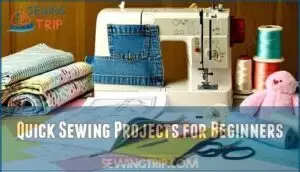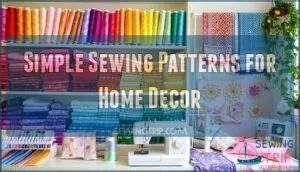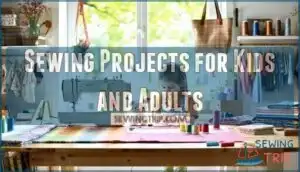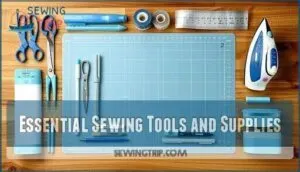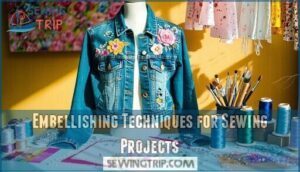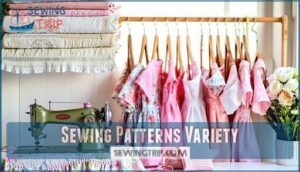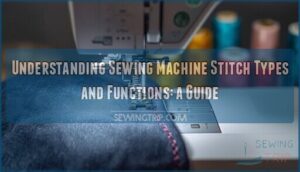This site is supported by our readers. We may earn a commission, at no cost to you, if you purchase through links.
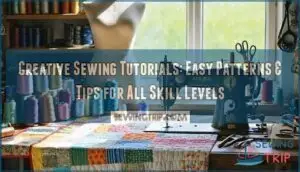 You’ll find creative sewing tutorials that transform basic skills into stunning projects.
You’ll find creative sewing tutorials that transform basic skills into stunning projects.
Whether you’re stitching your first fabric scrunchie or tackling heat transfer vinyl appliques, online communities like WithWendy and Coolirpa offer step-by-step guidance that makes even complex techniques feel manageable.
From upcycling vintage doilies into elegant table runners to creating personalized tote bags, these tutorials blend practicality with artistic flair.
The secret lies in choosing projects that match your skill level while pushing your boundaries just enough to keep things interesting—something most sewists discover only after a few wonderfully imperfect attempts to find the right balance between skill and creativity, which is the key to making stunning projects.
Table Of Contents
Key Takeaways
- You’ll find vibrant online communities like WithWendy and Coolirpa that transform solo sewing into collaborative learning through step-by-step tutorials, forums, and interactive challenges.
- You can start with beginner-friendly projects like fabric scrunchies and tote bags that teach essential techniques without pressure, then gradually advance to complex methods like heat transfer vinyl appliques.
- You’ll master professional-looking results by investing in quality tools like fabric scissors and rotary cutters, then learning embellishment techniques that transform ordinary items into stunning conversation pieces.
- You can build lasting confidence by embracing "wonderfully imperfect attempts" as valuable learning opportunities while following structured tutorials that match your skill level and push creative boundaries.
Sewing Communities Online
You’ll discover vibrant online sewing communities that transform solitary stitching into shared creativity and support.
These digital spaces connect you with fellow sewists who’ll answer your questions, celebrate your successes, and inspire your next project through tutorials, forums, and interactive challenges.
Where creativity meets community and every stitch tells a story
YouTube Channels for Sewing
When you’re ready to elevate your sewing game, YouTube channels offer treasure troves of visual learning.
These platforms transform complex techniques into digestible video tutorials that you can replay until you’ve mastered each stitch.
Here are four standout channels that’ll spark your creativity:
- WithWendy – Weekly clothing DIY projects with crystal-clear instructions for 1.5M+ devoted followers
- Coolirpa – Ingenious upcycling transformations that’ll make you see old clothes with fresh eyes
- Professor Pincushion – Step-by-step guidance perfect for building confidence across all skill levels
- Sew Very Easy – Laura Coia’s approachable teaching style makes quilting and garment construction feel achievable
These creator styles range from beginner-friendly basics to advanced techniques, ensuring you’ll find project inspiration regardless of your current abilities.
Many find that the best way to start is with beginner-friendly projects, which help build confidence.
Sewing Blogs and Websites
Discovering quality sewing blogs and sewing websites transforms your crafting journey completely.
Tilly and the Buttons delivers jargon-free instructions with excellent tutorial quality and boasts 281K Instagram followers for solid blog credibility.
Mood Designer Fabrics Sewciety Blog covers everything from beginner tips to advanced patternmaking, offering incredible pattern availability and project inspiration.
WeAllSew inspires creativity across skill levels with community features that connect sewists worldwide.
These platforms provide online tutorials and sewing inspiration that’ll keep your creative spark alive.
For sewists seeking guidance, consider exploring blogs for curvy sewing to find inspiration.
Online Sewing Forums and Groups
Beyond blogs, online sewing forums and groups offer vibrant spaces where you’ll find your tribe of fellow creators.
Find your creative tribe in spaces where inspiration flows freely and support never ends.
These communities thrive on collaboration, with members sharing everything from troubleshooting tips to celebrating finished projects. You’ll discover pattern swaps, community challenges, and skill-sharing sessions that’ll push your creativity forward.
Where sewing magic happens through shared wisdom and endless encouragement
Here’s what makes sewing forums special:
- Forum Etiquette creates welcoming spaces for all skill levels
- Project Showcases let you share work and receive helpful feedback
- Pattern Swaps refresh your collection without spending money
- Community Challenges motivate you to try new techniques
These sewing groups transform solo crafting into shared adventures through online tutorials and collective support.
Easy Sewing Projects
When you’re ready to transform fabric scraps into something amazing, easy sewing projects offer the perfect starting point for building your skills.
From fabric scrunchies that take just minutes to complete to cozy tote bags that’ll hold all your essentials, these beginner-friendly projects let you practice basic techniques without the pressure of perfection.
Quick Sewing Projects for Beginners
For new sewers starting out with their first projects, these quick beginner sewing options will build your confidence fast.
Start with fabric scrunchies, stuffed hearts, or drawstring pouches—perfect for practicing basic seam finishes while creating useful items.
| Project | Skills Practiced |
|---|---|
| Fabric Scrunchies | Pattern simplicity, seam basics |
| Sleep Masks | Tool essentials, straight stitching |
| Tea Pouches | Project customization, hand sewing |
| Denim Totes | Fabric selection, machine stitching |
These easy sewing projects teach essential techniques through beginner sewing tutorials that focus on practical results over perfection.
Simple Sewing Patterns for Home Decor
Transform your space with home decor sewing patterns that blend style and practicality.
These sewing tutorials let you create stunning pieces while mastering essential techniques.
Fabric selection and color palettes make each project uniquely yours.
For beginners, consider easy DIY pillow projects to start.
- Ruffled pillowcases: Perfect for practicing seams while adding bedroom charm
- Vintage doily table runners: Upcycle treasured textiles into elegant dining decor
- Quilted wall hangings: Build skill level through pattern customization and creative layouts
These sewing ideas prove that beautiful home decor doesn’t require expert-level expertise.
Sewing Projects for Kids and Adults
Sewing creates perfect bonding moments between generations.
You’ll find that age-appropriate projects like felt toys and simple costumes spark creative expression while building essential skills. Safety considerations matter most—use blunt needles and beginner-friendly fabrics.
| Kids Projects | Adult Projects |
|---|---|
| Felt animal shapes | Custom tote bags |
| Simple fabric bookmarks | Embroidered pillowcases |
| No-sew tie blankets | Quilted table runners |
| Button practice boards | Custom-made clothing items |
| Colorful scrunchies | Home décor accents |
These DIY sewing adventures transform skill development into shared memories while exploring countless sewing tutorials together.
Sewing Techniques Tips
You’ll master essential techniques that transform basic sewing into polished, professional-looking projects.
These methods help you create stunning embellishments and durable finishes that make your handmade items stand out from store-bought alternatives, using techniques that help you achieve professional-looking results.
Essential Sewing Tools and Supplies
Having the right gear can make or break your sewing journey.
Quality sewing tools and sewing supplies transform frustrating projects into enjoyable experiences.
Here are your essential tools:
- Fabric Scissors – Keep these sacred for fabric only (paper dulls blades faster than you’d think)
- Rotary Cutters with self-healing mats for precise strips and curves
- Measuring Tools like flexible tape measures and clear rulers for accuracy
- Marking Tools including washable pens and chalk for temporary guidelines
- Pressing Tools such as a reliable iron for professional-looking seams
These sewing essentials support any sewing tutorials you’ll tackle.
Using pinking shears prevents fabric fraying.
Smart investments here save hours of frustration later.
Heat Transfer Vinyl Applique Methods
Beyond the ordinary world of basic sewing lies a game-changing technique that’ll revolutionize your projects. Heat transfer vinyl applique transforms plain fabrics into stunning masterpieces with just the right approach.
Start with HTV fabric compatibility—cotton and polyester blends work best. Use design software tips to size your pattern perfectly, then adjust cutting machine settings for clean cuts.
Master weeding techniques by removing excess vinyl carefully around intricate details. The magic happens with proper heat press settings—typically 280°F-350°F for 8-20 seconds, depending on your vinyl type.
Always use a heat-resistant sheet to protect your design. You can find various types of vinyl for different projects. These applique methods create professional-looking embellishment techniques that’ll make your sewing tutorials shine with vibrant, durable results.
Embellishing Techniques for Sewing Projects
Once you’ve mastered HTV applique, fabric painting opens new creative doors for your projects.
Embroidery stitches add texture and personality, while sequin flowers create stunning focal points.
Applique methods let you layer fabrics for dimensional effects.
Creative sewing tutorials teach advanced embellishment techniques like beading and fabric manipulation.
Quality materials make all the difference—premium threads won’t break mid-stitch like bargain alternatives.
These HTV designs and decorative touches transform ordinary items into conversation starters.
Many crafters begin with pre-designed HTV patterns to simplify their projects.
Sewing Patterns Variety
You’ll discover endless possibilities when exploring different sewing patterns, from elegant ruffled pillowcases that transform your bedroom into a cozy retreat.
Whether you’re drawn to vintage charm with doily table runners or practical kids’ rompers, there’s a pattern that matches your style and skill level perfectly.
Ruffled Pillow Cases and Quilt Patterns
Transform your space into a romantic haven with charming ruffled pillowcases that’ll make you feel like you’re sleeping on clouds.
These vintage quilts combine timeless elegance with cozy comfort, perfect for adding personality to any bedroom.
Master these ruffle techniques using lightweight cotton or linen for best results. You’ll gather fabric strips at 1.5-2x the pillow’s perimeter, creating beautifully even ruffles that won’t overwhelm your design.
- Fabric Selection: Choose cotton or linen in 1.5-yard cuts for standard pillowcases—pre-wash to prevent shrinkage surprises
- Ruffle Techniques: Use longest machine stitch with high tension, dividing edges into quarters for even distribution
- Quilt Customization: Mix bold graphics with textural elements like hand-stitched ruffles for 2025’s trending minimalist-meets-dimensional look
- Pattern Alterations: Adjust ruffle width from 2-6 inches—wider creates drama while narrower stays subtle and sophisticated
These sewing tutorials transform basic quilting designs into showstoppers through creative pattern alterations and thoughtful vintage quilts inspiration.
Vintage Doily Table Runner and Placemats
Give vintage doilies fresh purpose by creating stunning table runners and placemats through upcycling elegance. These sewing projects preserve textile history while adding timeless charm to your dining space.
You can also find inspiration with downloadable retro styles online.
| Project Type | Materials Needed |
|---|---|
| Table Runner | Mixed doilies, thread, pins |
| Placemats | Single/paired doilies, yarn |
Start with doily preservation by gently hand-washing and ironing pieces flat. Arrange overlapping patterns on your work surface, then secure with pins before using invisible hand stitches.
These lace techniques connect edges seamlessly while maintaining delicate details. Sewing tutorials recommend taking reference photos during layout to preserve your design.
Decor customization flourishes through asymmetrical arrangements—perfect for showcasing vintage doilies with modern flair.
Jelly Roll Rug and Kids Romper Patterns
Jelly roll rugs and kids rompers turn fabric scraps into treasured keepsakes. These sewing patterns let you experiment with Creative Fabric Combinations while building practical skills.
For jelly roll rugs, coil fabric strips and secure with a zigzag stitch. Fabric Strip Durability depends on cotton choices and reinforced seams. Rug Pattern Alterations help you create custom sizes—perfect for entryways or playrooms. Many crafters find inspiration for their projects using pre-cut fabric strips.
Kids rompers shine with Knit Fabric Flexibility. Stretchy materials accommodate Romper Size Variations as little ones grow. Pattern adjustments like lengthened legs or wider chest panels extend wear time.
Both projects offer forgiving sewing tutorials that welcome mistakes:
- Use contrasting thread colors to highlight spiral patterns in rugs
- Pre-wash knits to prevent romper shrinkage after construction
- Save fabric remnants for coordinating accessories like headbands or bookmarks.
These beginner-friendly patterns transform ordinary materials into extraordinary handmade pieces.
Learning Sewing Skills
You’ll discover that learning sewing doesn’t have to feel overwhelming when you have the right resources and approach.
Whether you’re starting with your first straight stitch or ready to tackle advanced tailoring techniques, there’s a perfect learning path waiting for you.
Online Sewing Courses and Tutorials
Your sewing journey’s success depends heavily on choosing the right online courses and tutorials that match your learning preferences. Today’s digital landscape offers incredible course variety, from free YouTube channels to thorough paid programs with expert guidance.
Consider these popular options for skill building:
| Format | Best For | Price Range | Time Commitment | Instructor Support |
|---|---|---|---|---|
| Free Video Tutorials | Visual learners | $0 | Self-paced | Comments only |
| Structured Online Courses | Detailed learning | $25-$150 | 4-8 weeks | Direct feedback |
| Live Virtual Classes | Real-time help | $40-$200 | 2-3 hours weekly | Interactive support |
| Subscription Platforms | Ongoing education | $15-$30/month | Unlimited access | Community forums |
| One-on-One Lessons | Personalized instruction | $50-$100/hour | Flexible scheduling | Dedicated mentor |
Different learning styles thrive with different approaches. Visual learners love detailed sewing tutorials, while hands-on learners prefer interactive sewing lessons. Cost comparison shopping helps you find quality sewing instruction without breaking the bank. The key? Start with free resources, then invest in structured courses as your confidence grows.
Sewing Patterns for Beginners and Experts
Whether you’re stitching your first straight seam or tackling complex pattern drafting, the right sewing patterns can transform your skills.
Pattern complexity naturally builds through skill progression—start with simple tote bags, then advance to bespoke garments with intricate design personalization.
Here’s your roadmap for sewing success:
- Master basic sewing techniques through beginner-friendly patterns before attempting advanced sewing projects
- Explore customization options like unique trims and fabric choices to personalize every creation
- Practice pattern drafting fundamentals to reveal unlimited design possibilities
Online sewing tutorials make even challenging patterns achievable, guiding you through each step with clarity and confidence.
Building Confidence in Sewing Skills
Once you’ve chosen beginner-friendly patterns, Mastering Basics becomes your foundation for building lasting sewing confidence. Start with Practice Projects that won’t break your heart if they go sideways—like simple tote bags or drawstring pouches that actually get better with character marks.
Overcoming Fear happens one stitch at a time. Remember, even master sewists once threaded their needles backward (yes, really). Focus on Skill Progression rather than perfection. Each wonky seam teaches you something valuable about tension or fabric behavior.
Celebrating Success means acknowledging every small win. Finished your first pillowcase? That’s huge! The skillbuilding process thrives on these moments of pride.
Sewing tutorials become your best friends during challenging techniques. Don’t rush—sewing skills develop through patient repetition and embracing mistakes as learning opportunities.
Frequently Asked Questions (FAQs)
Are creative sewing tutorials worth it?
With the global sewing machine market reaching $56-25 billion in 2024, you’re clearly not alone in your crafting curiosity.
Creative sewing tutorials are absolutely worth it—they’ll transform your skills, spark innovation, and connect you with a vibrant community of makers.
How do you make a good sewing tutorial?
Plan your shots carefully, show clear close-ups of techniques, speak slowly while demonstrating, use good lighting, and edit out mistakes.
Include supply lists, troubleshooting tips, and encourage viewers throughout your tutorial to ensure a comprehensive learning experience with clear instructions.
How do I start sewing?
Start with essential tools: sharp fabric scissors, measuring tape, pins, and a reliable sewing machine.
Choose beginner-friendly cotton fabric and simple projects like tote bags or pillowcases to build confidence while learning basic stitches, which will help you to develop your skills and become more proficient in using your sewing machine.
When does learn to sew start?
Like planting a garden, your sewing journey begins the moment you pick up your first needle and thread.
You’ll start learning basic stitches immediately, building skills through simple projects like scrunchies or drawstring pouches that teach fundamental techniques.
How can I teach my kids to sew?
Teaching kids to sew builds patience and creativity while creating lasting memories together. Start with simple projects like scrunchies or felt toys, using blunt needles and easy fabrics for safety.
Where can I find free sewing tutorials?
The global sewing machine market reached $25 billion in 2024, showing how popular sewing’s become.
You’ll discover excellent free tutorials on YouTube channels like Sara’s Sewing Therapy and blogs like Sewspire.com for step-by-step guidance.
How do you make sewing fun?
Pick bright, playful fabrics that spark joy, tackle quick projects for instant wins, share creations with online communities, and experiment with fun embellishments like sequins or appliques.
How can I improve my sewing skills?
Practice consistently by starting with beginner projects like tote bags, then gradually tackling complex patterns.
Join online communities for inspiration and feedback.
Watch YouTube tutorials, invest in quality tools, and don’t fear mistakes—they’re learning opportunities.
What is the most profitable thing to sew?
Home decor items like pillows, table runners, and tote bags offer solid profit margins.
You’ll find custom embroidery work, children’s clothing, and alterations particularly lucrative since they command higher prices for personalized service.
What’s the hardest thing to sew?
Like climbing Everest with a needle, you’ll find custom suits are sewing’s ultimate challenge.
You’re wrestling with precise measurements, complex construction, multiple fittings, and intricate details that demand years of experience.
Conclusion
Practice makes perfect, and with creative sewing tutorials at your fingertips, you’ll transform from hesitant beginner to confident creator.
These step-by-step guides remove the guesswork from complex techniques, making heat transfer vinyl and vintage doily projects surprisingly achievable.
You’ll discover that each "wonderfully imperfect" attempt teaches valuable lessons, building skills one stitch at a time.
Start with simple projects, embrace mistakes as learning opportunities, and watch your creativity flourish through these accessible, well-designed tutorials.

